- Self-powered perovskite/CdS heterostructure photodetectors
Journal: ACS Applied Materials & Interfaces Title: "Self-powered perovskite/CdS heterostructure photodetectors" Authors: Li, Zibo; Li, Henan*; Jiang, Ke; Ding, Dong; Li, Jieni; Ma, Chun; Jiang, Shangchi; Wang, Ye; Anthopoulos, Thomas*; Shi, Yumeng*
Accepted for Publication, ACS Appl. Mat. Interfaces 2019
https://doi.org/10.1021/acsami.9b11835
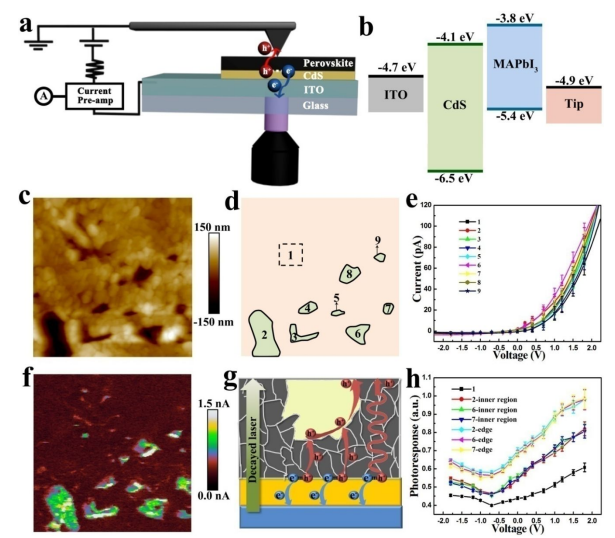
- Dendrite-free Li metal plating/stripping onto three-dimensional vertical-graphene@carbon-cloth host
Dendrite-free Li metal plating/stripping onto three-dimensional vertical-graphene@carbon-cloth host, Front. Chem, doi:10.3389/fchem.2019.00714
- Influence of the Organic Chain on the Optical Properties of Two-dimensional Organic-Inorganic Hybrid Lead Iodide Perovski
Guangyou Liu, Chuntian Qiu, Bingbing Tian,* Xiangning Pan, Dong Ding, Yu Chen, Can Ren, Tingchao He, Yumeng Shi, Chenliang Su, Ying Li, Yanxia Gao, and Dianyuan Fan, Influence of the Organic Chain on the Optical Properties of Two-dimensional Organic-Inorganic Hybrid Lead Iodide Perovskites, ACS Applied Electronic Materials, 2019
Two-dimensional (2D) organic-inorganic hybrid perovskites (OIHPs) have recently drawn great interest due to their easy synthesis and excellent photoelectric properties. With tunable bandgaps, 2D OIHPs have been widely investigated for use in optoelectronic sensors, photodetectors and solar cells. In this work, we synthesized three types of 2D perovskites with different organic chains, (CH3(CH2)3NH3)2PbI4 (C4, (BA)2PbI4), (CH3(CH2)5NH3)2PbI4 (C6, (HA)2PbI4) and (CH3(CH2)7NH3)2PbI4 (C8, (OA)2PbI4), and investigated their photoelectric properties. With increasing organic chain length, the inter-layer spacing, bandgaps and stability in air increased correspondingly. In addition, tunable optoelectronic properties were achieved when these three perovskites with different organic chain cations were employed to fabricate photodetectors. The results provide an effective method for synthesizing various OIHPs via tuning different organic cations and are helpful to broaden the applications of OIHPs in photoelectric devices.
- High-Concentration Niobium-Substituted WS2 Basal Domains with Reconfigured Electronic Band Structure for Hydrogen Evoluti
High-Concentration Niobium-Substituted WS2 Basal Domains with Reconfigured Electronic Band Structure for Hydrogen Evolution Reaction.
Pam, Mei Er; Hu, Junping; Ang, Yee Sin; Huang, Shaozhuan; Kong, Dezhi; Shi, Yumeng; Zhao, Xiaoxu; Geng, Dechao; Pennycook, Stephen J; Ang, Lay Kee; Yang, Hui Ying*
ACS applied materials & interfaces DOI:10.1021/acsami.9b08232
Extrinsically controlling the intrinsic activity and stability of two-dimensional (2D) semiconducting materials by substitutional doping is crucial for energy-related applications. However, an in situ transition-metal doping strategy for uniform and large-area chemical vapor deposited 2D semiconductors remains a formidable challenge. Here, we successfully synthesize highly uniform niobium-substituted tungsten disulfide (Nb-WS2) monolayers, with a doping concentration of nearly 7% and sizes reaching 100 mum, through a metal dopant precursor route, using salt-catalyzed chemical vapor deposition (CVD). Our results reveal unusual effects in the structural, optical, electronic, and electrocatalysis characteristics of the Nb-WS2 monolayer. The Nb dopants readily induce a band restructuring effect, providing the most active site with a hydrogen adsorption energy of 0.175 eV and hence greatly improving its hydrogen evolution activity. The combined advantages of the unusual physics and chemistry by in situ CVD doping technique open the possibility in designing 2D-material-based electronics and catalysts of novel functionalities.
- Continuous desalination with a metal-free redox-mediator
Continuous desalination with a metal-free redox-mediator
Jian Wang, Qi Zhang, Fuming Chen,* Xianhua Hou, Zhilie Tang, Yumeng Shi, Peng Liang, Denis Y. W. Yu, Qinyu He* and Lain-Jong Li*
J. Mater. Chem. A, 2019,7, 13941-13947
Abstract
Deionization using electrochemical redox reactions has potentially been the latest desalination technique with high salt removal capacity and lower energy cost due to high capacity of electrode materials and electrochemical energy release. Herein, we presented a metal-free continuous electrodialysis desalination technology, which could directly desalt feed water at high concentrations to drinking water level during continuous treatment with unlimited salt removal capacity. The device consists of a recirculating 4-hydroxy-2,2,6,6-tetramethylpiperidine 1-oxyl (TEMPO) stream between the flowing positive and negative electrodes in series and the salt feed stream. During the charging process, the flowing TEMPO was oxidized at the positive reservoir, where the anion in the feed was captured through the anion exchange membrane, whereas the TEMPO recovery at the negative reservoir drove the cation removal in the feed through the cation exchange membrane by its reduction. Due to the redox reaction of TEMPO between the cyclical flow electrode streams, it acts as a “catalyst”, and the salt ions in the middle feed are continuously extracted. Our experiments demonstrate that feed water with a 5860 ppm salt concentration can be directly desalted to 136 ppm, a drinking water level, in a single batch treatment during the continuous charging process (salt removal of up to 97.7%). Furthermore, a three-membrane device was demonstrated to stop the salt concentration increase in the TEMPO electrode reservoirs; thus, fully continuous cycling of the TEMPO catalyst was realized without any salt change in the electrode reservoirs. Our research will provide a route for metal-free continuous desalination based on the molecular redox mediator of the electrode material and can be applied directly in open air environment and room temperature.
- Post-Treatment of CH3NH3PbI3/PbI2 Composite Films with Methylamine to Realize High-Performance Photoconductor Devices
Jieni Li,Henan Li,* Lai Liu, Huizhen Yao, Bingbing Tian, Chenliang Su, HaizheZhong, Ye Wang, Lifu Zhang, and Yumeng Shi*
Chem.Asian J. 2019, 14,2861–2868
Abstract: Organometallic halide perovskites have attracted great research interest as light-activematerials for use in optoelectronics. Here, we report ahigh-performancephotoconductor based on amethylammonium lead iodide (MAPbI3) film that was prepared from amethylamine-treatedMAPbI3/ PbI2 perovskite film. An ultrahigh responsivity of 3.6 A/W and detectivity of 5.4x1012 Jones wereobtained for the film under 0.5 mW/cm2 white-light illumination. In addition, under 420 nm light irradiation, the film exhibited its highest responsivity and detectivity of 30 AW@1 and 2.4x1014 Jones, respectively.The excellent photo-response performance results from the improved electronic quality andsuppressed nonradiative recombination channels of the treated perovskite thin film.
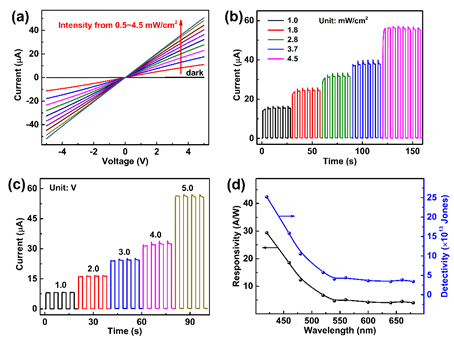
- Diffusion-Enhanced Fe1-xS/MoS2 Heterostructure for High-Performance Sodium Storage
Diffusion-Enhanced Fe1-xS/MoS2 Heterostructure for High-Performance Sodium Storage
Song Chen,a,b,† Shaozhuan Huang,b,† Junping Hu,b Shuang Fan,b Yang Shang,b Mei Er Pam,b Xiaoxia Li,b Ye Wang,d Congcong Yang,d Yumeng Shi,a,c,* Hui Ying Yangb,*
DOI :10.1007/s40820-019-0311-z. Nano Micro Letters
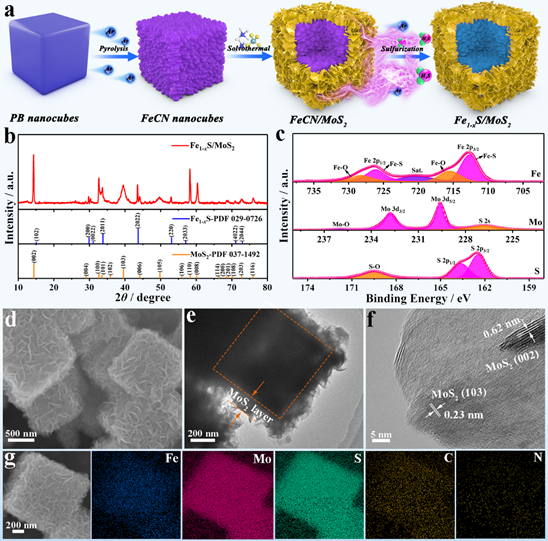
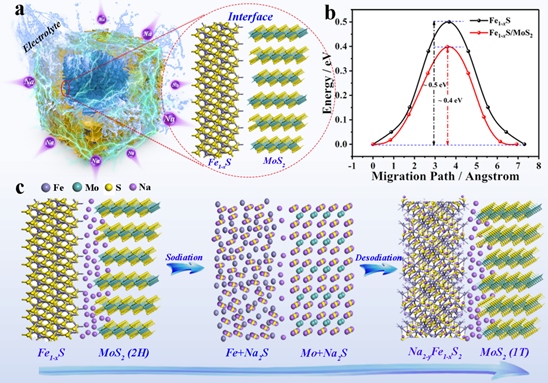
- Template growth of perovskites on yarn fibers induced by capillarity for flexible photoelectric applications
作者:Dong Ding, Henan Li*, Huizhen Yao, Lai Liu, Bingbing Tian, Chenliang Su, Ye Wang, Yumeng Shi
发表杂志: Journal of Materials Chemistry C,
J. Mater. Chem. C, 2019,7, 9496-9503
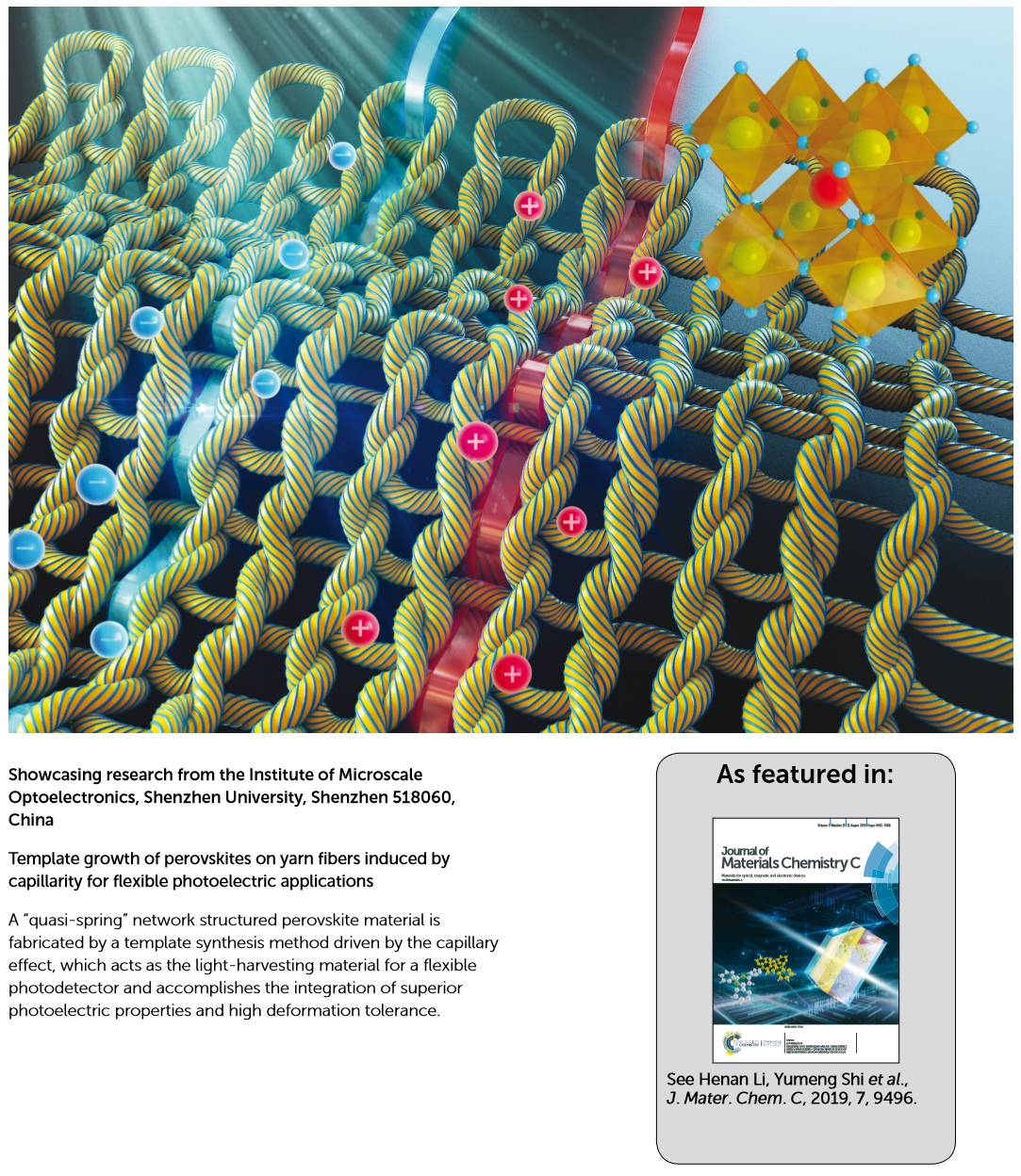
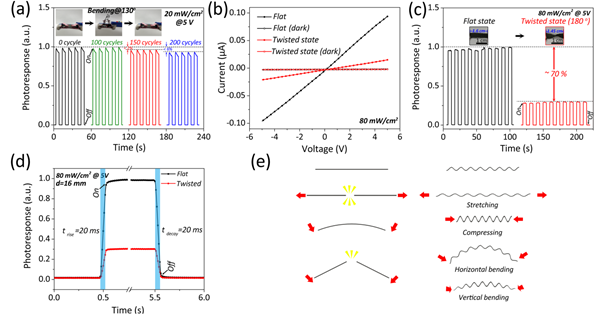
- An all manganese-based oxide nanocrystal cathode and anode for high performance lithium-ion full cells
作者:Song Chen,a,d Wei Xia,b Ye Wang,c Hui Ying Yang,d Yumeng Shi,*,a
发表杂志 Nanoscale Advences
Abstract
Designing zero-dimensional (0D) manganese oxide nanostructures to shorten lithium ion diffusion length and accelerate interfacial charge transfer is of great meaning for the achievement of advanced high-performance lithium ion batteries. Here we present the size-controlled synthesis of monodisperse MnO nanocrystals by a simple one-pot pyrolysis method, and the comparative study regarding the effect of crystallite size on electrochemical stability. Nanocrystalline MnO with a size of about 10 nm shows the optimal lithium-storage performance. After carbon encapsulation, the MnO/C nanocomposite realizes high reversible capacity, remarkable cycling stability and good rate capability. In addition, spinel LiMn2O4 nanocrystals have been synthesized by the chemical conversion of MnO nanocrystals, which also exhibit stable cyclability and excellent high-rate performance. Remarkably, the MnO/C//LMO full cell shows a promising potential in the next-generation lithium ion batteries. These current findings not only significantly improve electrochemical properties of Mn-based materials, but also open up avenues for the future development of various energy devices.
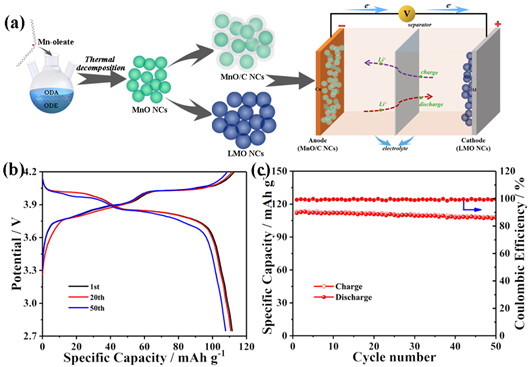
- Tunable Pseudocapacitive Behavior in Metal-Organic Framework-Derived TiO2@Porous Carbon Enabling High-Performance Membran
作者:Ding, M.; Fan, S.; Huang, S.; Pam, M. E.; Guo, L.; Shi, Y.; Yang, H. Y.*
发表杂志:ACS Applied Energy Material 卷 2 期 3 页 1812-1822
Abstract
Titanium dioxide (TiO2) composites have shown promise in desalination as electrode materials of capacitive deionization (CDI). However, it remains a significant challenge to explore their pseudocapacitive potential for further enhancement of salt adsorption capacity and long-term stability. Herein, we report a titanium dioxide/porous carbon composite (TiO2@PC) with tunable pseudocapacitance for a high-performance membrane CDI (MCDI) based on a metal–organic frameworks (MOFs)-derived strategy. By controlling the pyrolysis conditions, the crystalline degree and specific surface areas of TiO2@PC samples have been optimized to improve the salt adsorption performance. A synergy of high pseudocapacitance and good oxidation resistance endows the anatase TiO2@PC (annealed at 600 °C) with an improved salt adsorption capacity of 46.7 mg g–1 at 10 mA g–1 and stable cycling performance over 50 cycles. These properties reveal the great potential of anatase TiO2@PC to serve as a promising candidate of electrode materials for MCDI.
- Location-selective growth of two-dimensional metallic/semiconducting transition metal dichalcogenide heterostructures
作者:Gong, X.; Zhao, X.; Pam, M. E.; Yao, H.; Li, Z.; Geng, D.; Pennycook, S. J.; Shi, Y*.; Yang, H. Y.
发表杂志:Nanoscale 卷 11 期 10
Abstract
An electrical contact between metallic electrodes and semiconductors is critical for the performance of electronic and optoelectronic devices. Two-dimensional (2D) transition metal dichalcogenides (TMDs) contain semiconducting, metallic and insulating material members, which enables the fabrication of highly integrated electronic devices fully based on 2D TMDs. However, location-selective synthesis of metallic/semiconducting heterostructures by a chemical vapor deposition (CVD) method has rarely been reported. In this study, a two-step CVD method was applied to fabricate 2D metallic/semiconducting heterostructures. Semiconducting WS2 was first synthesized and served as the template for the following CVD growth of metallic NbS2. In the growth process, NbS2 flakes selectively nucleate at the edges of WS2 monolayers, thus resulting in the formation of NbS2 islands circling around the WS2 monolayers. The as-grown NbS2/WS2 heterostructure was further systematically characterized by Raman spectroscopy, atomic force microscopy (AFM) and scanning transition electron microscopy (STEM). The NbS2 layers epitaxially grown on the WS2 monolayers exhibit a 3R phase and there was no discernible lattice strain in the NbS2/WS2 van der Waals (vdW) heterostructure. The growth of the metallic/semiconducting 2D heterostructures could benefit the nanoelectronic device fabrication and provide a platform for the 2D contact resistance study.
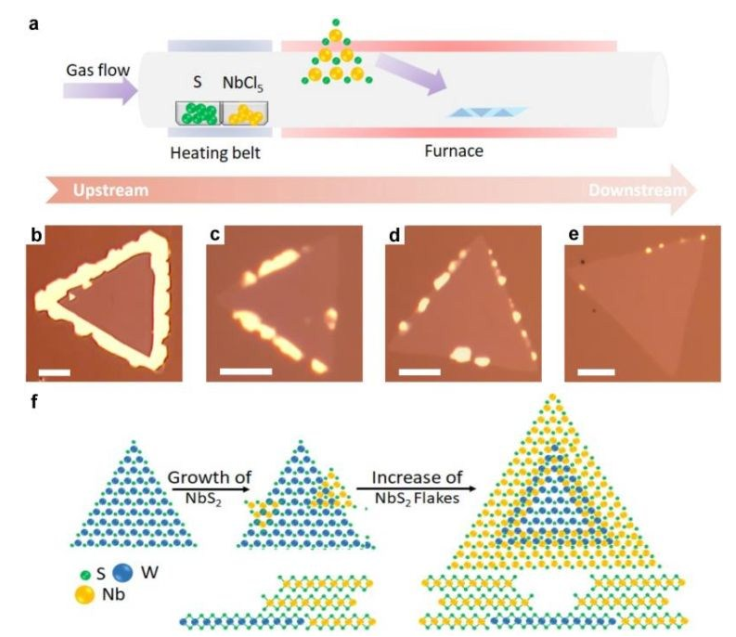
- Electrochemical Performance of Sb4O5Cl2 as a New Anode Material in Aqueous Chloride-Ion Battery
作者:Hu, X.; Chen, F*; Wang, S.; Ru, Q.; Chu, B.; Wei, C.; Shi, Y.; Ye, Z.; Chu, Y.; Hou, X.; Sun, L*
发表杂志:ACS Applied Materials & Interfaces
Abstract
Chloride-ion battery is considered as the (a) _ promising electrochemical system due to its high energy density in theory. However, aqueous chloride-ion redox materials are limitedly reported owing to their instability or dissolution in aqueous electrolyte. Here, we synthetize a new electrochemicalchloride-ion material, Sb4O5Cl2, investigate its electrochemical performance in aqueous NaCl electrolyte, and assemble into aqueous chloride-ion battery with silver as cathode. During the batterycharge process, Sb4O5Cl2 anode electrochemically releases chloride ions, which are captured by Ag cathode with the formation of silver chloride while the discharging reverses the process. The batterydemonstrates favorable electrochemical performance. With current density of 600 mA g(-1), the battery discharge capacity of 34.6 mAh g(-1) can be maintained for 50 cycles. This work is greatly significant for the development of anion electrochemical energy storage.
- 3D self-branched zinc-cobalt Oxide@N-doped carbon hollow nanowall arrays for high-performance asymmetric supercapacitors
作者:Kong, D.; Wang, Y.; Huang, S.; Hu, J.; Lim, Y. V.; Liu, B.; Fan, S.; Shi, Y.; Yang, H. Y.
发表杂志:Energy Storage Materials
Abstract
This study reports the design and fabrication of ultrathin zinc-cobalt oxide nanoflakes@N-doped carbon hollow nanowall arrays (ZnCo2O4@NC NWAs) from vertically aligned 2D Co-MOF solid nanowall arrays by controllable cation ion-exchange and post annealing strategies. The unique 3D self-branched nanostructure anchored on flexible carbon textiles (CTs) can offer short ion diffusion length, fast and continuous electron transport pathway, and abundant reaction active sites. More importantly, the rational incorporation of Zn2+ generates hollow structure as well as reduces the intrinsic band gap, which further enhance the ion transportation efficiency and electronic conductivity. The above superiorities endow the 3D self-branched ZnCo2O4@NC/CTs electrodes with remarkable performances in terms of flexible asymmetric supercapacitor and oxygen electrocatalysis. When evaluated as a flexible cathode for asymmetric supercapacitor, the as-fabricated ZnCo2O4@NC/CTs electrode exhibits outstanding electrochemical performance with a wide work voltage up to 2.0 V, high areal energy density of 0.278 mWh cm-2 (or volumetric energy density of 2.32mWh cm-3) and long-term cycling stability (~85.89% capacitance retention over 6000 cycles).
Additionally, the ZnCo2O4@NC/CTs electrode shows excellent oxygen evolution reaction (OER) performance with a small overpotential of 196.4 mV at 10 mA cm−2 and long-term durability (over 45 h). This work provides a rational design strategy for controllable synthesis of 3D self-branched hollow nanostructure on flexible substrate for energy storage and conversion applications.
- High-Performance Photoresistors Based on Perovskite Thin Film with a High PbI2 Doping Level.
作者:Li, J.; Li, H.; Ding, D.; Li, Z.; Chen, F.; Wang, Y.; Liu, S.; Yao, H.; Liu, L.; Shi, Y.
发表杂志:Nanomaterials 卷 9 期 4
Abstract
We prepared high-performance photoresistors based on CH3NH3PbI3 films with a high PbI2 dopinglevel. The role of PbI2 in CH3NH3PbI3 perovskite thin film was systematically investigated using scanning electron microscopy, X-ray diffraction, time-resolved photoluminescence spectroscopy, and photoconductive atomic force microscope. Laterally-structured photodetectors have been fabricated based on CH3NH3PbI3 perovskite thin films deposited using precursor solution with various CH3NH3I:PbI2 ratios. Remarkably, the introduction of a suitable amount of PbI2 can significantly improve the performance and stability of perovskite-based photoresistors, optoelectronic devices with ultrahigh photo-sensitivity, high current on/off ratio, fast photo response speed, and retarded decay. Specifically, a highest responsivity of 7.8 A/W and a specific detectivity of 2.1 x 10(13) Jones with a rise time of 0.86 ms and a decay time of 1.5 ms have been achieved. In addition, the local dependence of photocurrent generation in perovskite thin films was revealed by photoconductive atomic force microscopy, which provides direct evidence that the presence of PbI2 can effectively passivate the grain boundaries of CH3NH3PbI3 and assist the photocurrent transport more effectively.
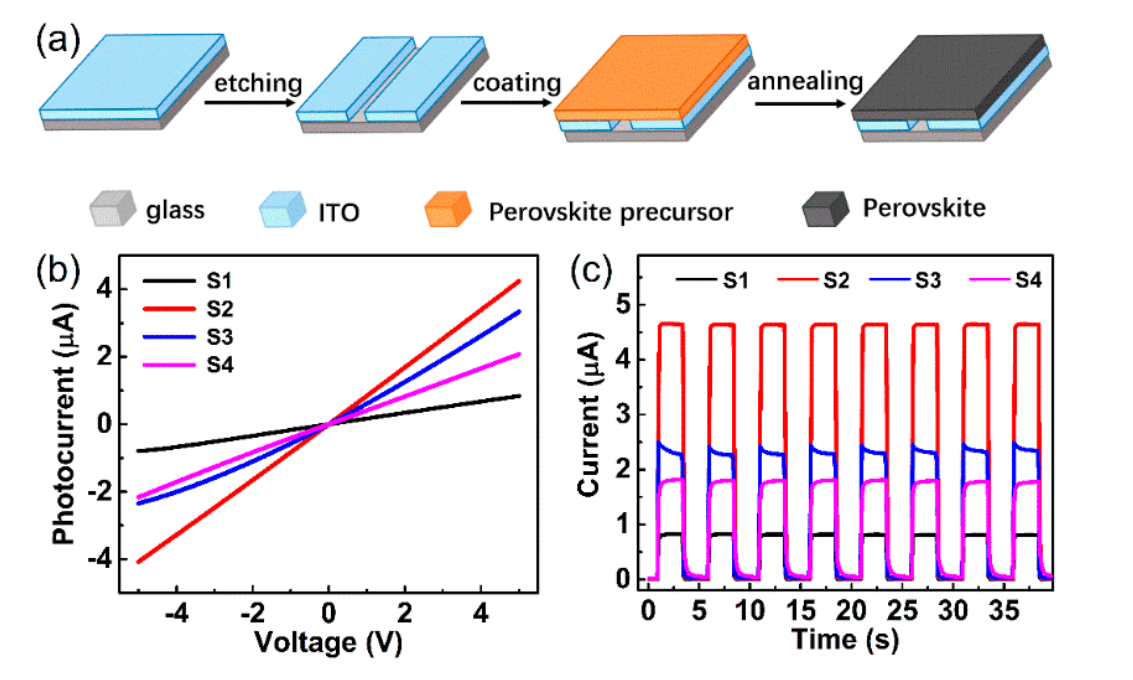
- Boosting the Electrocatalytic Water Oxidation Performance of CoFe2O4 Nanoparticles by Surface Defect Engineering
作者:Ou, G.; Wu, F.; Huang, K.; Hussain, N.; Zu, D.; Wei, H.; Ge, B.; Yao, H.; Liu, L.; Li, H.; Shi, Y*.; Wu, H.
发表杂志: ACS Applied Materials & Interfaces 卷 11 期 4 页 3978-3983
Abstract
Spinel oxides have attracted widespread interest for electrocatalytic applications owing to their unique crystal structure and properties. The surface structure of spinel oxides significantly influences the electrocatalytic performance of spinel oxides. Herein, we report a Li reduction strategy that can quickly tune the surface structure of CoFe2O4 (CFO) nanoparticles and optimize its electrocatalyticoxygen evolution reaction (OER) performance. Results show that a large number of defective domains have been successfully introduced at the surface of CFO nanopowders after Li reduction treatment. The defective CFO nanoparticles demonstrate significantly improved electrocatalytic OER activity. TheOER potential observed a negative shift from 1.605 to 1.513 V at 10 mA cm(-2), whereas the Tafel slope is greatly decreased to 42.1 mV dec(-1) after 4 wt % Li reduction treatment. This efficient Li reduction strategy can also be applied to engineer the surface defect structure of other material systems and broaden their applications.

- Effects of precursor pre-treatment on the vapor deposition of WS2 monolayers
作者:
Abstract
Transition metal oxide powders have been widely used as the growth precursors for monolayer transition metal dichalcogenides (TMDCs) in chemical vapor deposition (CVD). It has been proposed that metal oxide precursors in the gas phase undergo a two-step reaction during CVD growth, where transition metal sub-oxides are likely formed first and then the sulfurization of these sub-oxides leads to the formation of TMDCs. However, the effects of stoichiometry of transition metal oxide precursors on the growth of TMDC monolayers have not been studied yet. In this contribution, we report the critical role of the WO3 precursor pre-annealing process on the growth of WS2 monolayers. Besides, several WO3 precursors with different types of oxygen vacancies have also been prepared and investigated by X-ray powder diffraction (XRD), X-ray photoelectron spectroscopy (XPS) and density functional theory calculation. Among all the non-stoichiometric WO3 precursors, thermally annealed WO3 powder exhibits the highest oxygen vacancy concentration and produces WS2 monolayers with significantly improved quality in terms of lateral size, density, and crystallinity. Our comprehensive study suggests that the chemical composition of transition metal oxide precursors would be fundamentally critical for the growth of large-area and high-quality WS2 monolayers, which further pave the way for revealing their intrinsic properties and unique applications.
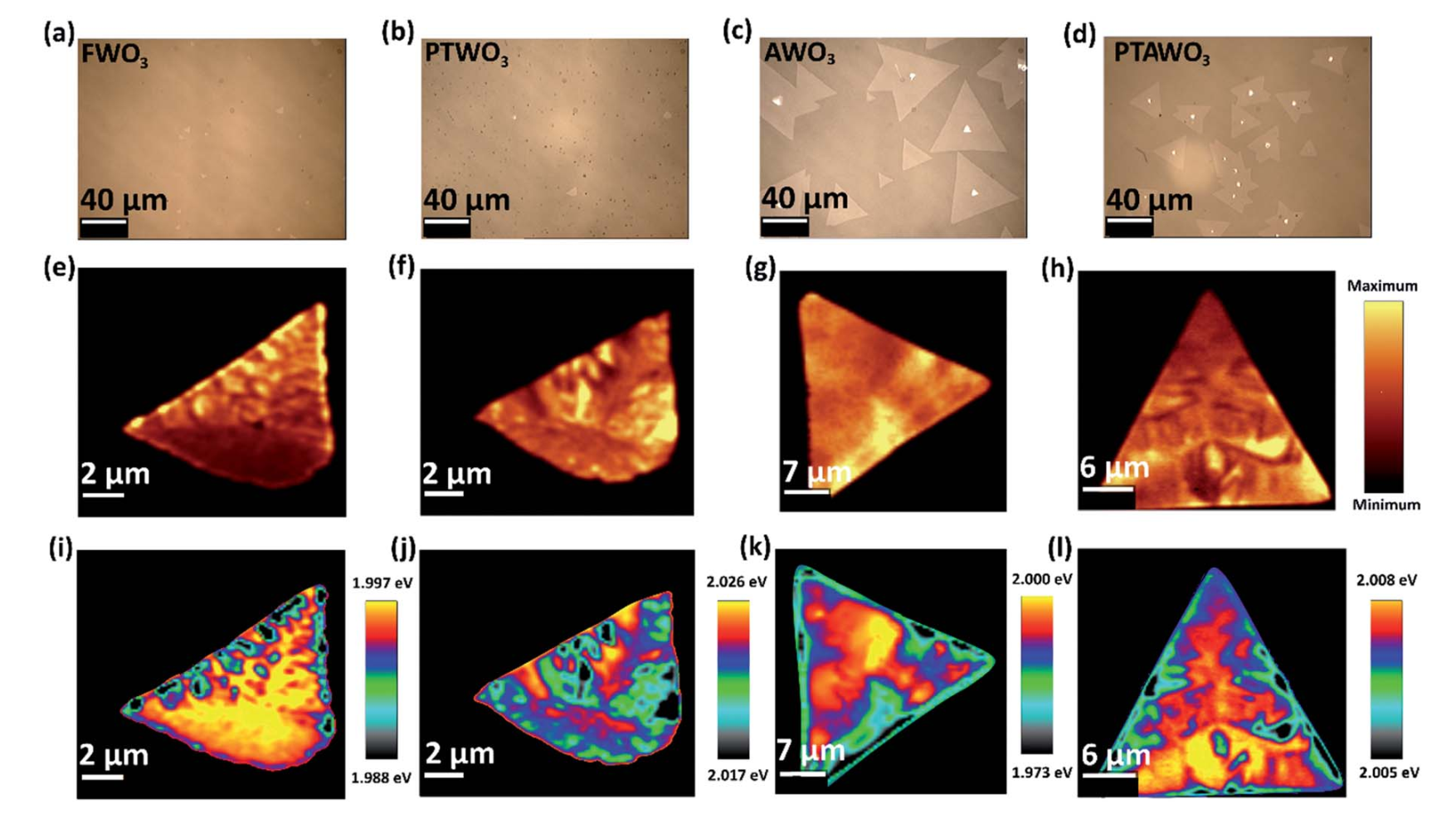
- Rhenium disulfide nanosheets/carbon composite as novel anodes for high-rate and long lifespan sodium-ion batteries
作者:Lim, Yew Von; (Huang, Shaozhuan ; Wu, Qingyun ; Zhang, Yingmeng ; Kong, Dezhi ; Wang, Ye ; Xu, Tingting ; Shi, Yumeng ; Ge, Qi ; Ang, Lay Kee
发表杂志:Nano Energy 卷 61 页 626-636
Abstract
Rhenium disulfide (ReS2) has recently amassed increasing interests as lithium-ion batteries (LIBs) anode material due to its extremely weak interlayer coupling and high Li storage capacity. However, its potential as high-performance sodium-ion batteries (SIBs) has rarely been explored comprehensively. In this work, we demonstrate a novel construct of ReS2 anode consisting of vertical ReS2 nanosheets uniformly grown on metal-organic framework (MOF) derived porous carbonaceous nanocubes (RESNC), is able to achieve high-performance SIBs. Exhibiting high specific surface area (117.40 m(2) g(-1)) and near-microporous (similar to 2.20 nm) pore size distribution, this unique and conductive nanostructure provides abundant reactive sites which enable rapid and efficient ions/electrons transportation. For the first time, the sodiation/desodiation redox mechanisms of the ReS2-based nanostructure are revealed via ex situ investigations. Our results demonstrated that RESCN nanocomposite is endued with high capacity (365 mA h g(-1), 100 mA g(-1)), high rate capability (up to 2 A g(-1)) and stable cycling performance (> 600 cycles, 2 A g(-1)). To elaborate on the rate and cycling capabilities, various diffusion pathways of sodium-ions on the ReS2 lattice were unravelled via first-principles/ab initio techniques, with the results indicating favourable diffusion mechanics. Through the joint approach of comprehensive experimental and theoretical investigations, our results suggest that the ReS2/C composites are highly promising as highperformance SIBs anode materials, as well as broadening the current perspectives of materials choices as far as high capacity transition metal disulfides (TMDs) is concerned.
- High Oxidation Resistance of CVD Graphene-Reinforced Copper Matrix Composites
作者:Wu, Mingliang; Hou, Baosen; Shu, Shengcheng ;Li, Ao; Geng, Qi ; Li, He; Shi, Yumeng ; Yang, Minghu ; Du, Shiyu ;Wang, Jun-Qiang
发表杂志:Nanomaterials 卷 9 期 4
Abstract
Copper-based materials are common industrial products which have been broadly applied to the fields of powder metallurgy, electrical contact, and heat exchangers, etc. However, the ease of surface oxidation limits the durability and effectiveness of copper-based components. Here, we have developed a powder metallurgy process to fabricate graphene/copper composites using copperpowders which were first deposited with graphene layers by thermal chemical vapor deposition (CVD). The graphene/copper composites embedded with an interconnected graphene network was then able to be obtained by vacuum hot-pressing. After thermal oxidation (up to 220 degrees C) in humid air for several hours, we found that the degree of surface oxidation of our samples was much less than that of their pure Cu counterpart and our samples produced a much smaller increase ofinterfacial contact resistance when used as electrical contact materials. As a result, our graphene/copper composites showed a significant enhancement of oxidation resistance ability (approximate to 5.6 times) compared to their pure Cu counterpart, thus offering potential applications as novel electrical contact materials.
- The photoluminescence mechanism of CsPb2Br5 microplates revealed by spatially resolved single particle spectroscopy
作者:Zhang Tianxiang, Chen Zhihui, Shi Yumeng, Xu Qing-Hua
发表杂志: Nanoscale 卷 11 期 7 页 3186-3192
DOI: 10.1039/C8NR10110H
Abstract
CsPb2Br5 is a new member of the all-inorganic lead halide perovskite family with unique structures and optoelectronic properties for various applications. As an indirect band gap semiconductor, the photoluminescence (PL) mechanism of CsPb2Br5 is still under debate. To resolve this issue, CsPb2Br5 microplates with strong green PL have been prepared by a hot-injection method. Characterization by transmission electron microscopy (TEM), X-ray diffraction (XRD) analysis and ultraviolet-visible (UV-vis) absorption spectroscopy indicates the existence of a small amount of embedded CsPbBr3 phase. The removal of the embedded CsPbBr3phase by treatment with water containing ethanol solvent resulted in complete PL quenching, suggesting the origin of PL due to the embedded CsPbBr3 phase. Spatially resolved PL and time-resolved PL mapping have been further employed to directly visualize the spatial distribution of different emission centers. Our single particle spectroscopic studies indicated the existence of three different emission centers with different PL lifetimes: two types of embedded CsPbBr3 phases (clumped and randomly distributed CsPbBr3 nanocrystals) and intrinsic defects of CsPb2Br5. The embedded CsPbBr3 phases with fast and intermediate PL lifetimes are the primary contributors to PL of the CsPb2Br5 microplates while their intrinsic defects with slow PL lifetimes make only a minor contribution. These studies have unambiguously clarified the PL mechanisms of the CsPb2Br5microplates and provided the direct mapping of different emission centers, which resolve the contradictory explanation and debate about the PL mechanism of the CsPb2Br5 microplates.
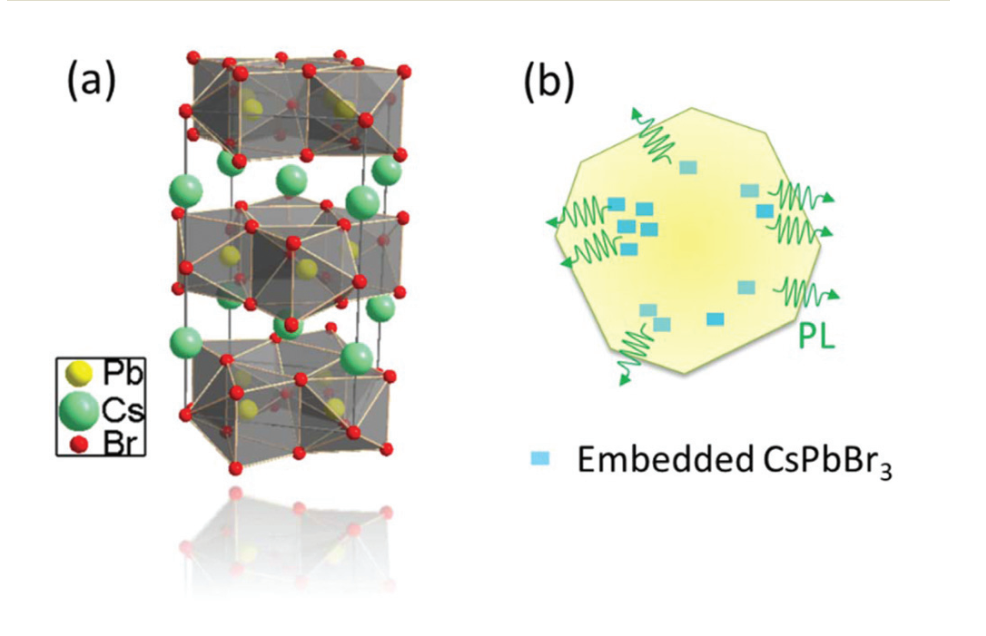
- Polypyrrole Coated Niobium Disulfide Nanowires as High Performance Electrocatalysts for Hydrogen Evolution Reaction
作者:Xue Gong, Dezhi Kong, Shaozhuan Huang, Lu Guo, Mei Er Pam, Shuang Fan, Ye Wang, Yanxia Gao, Yumeng Shi, Hui Ying Yang
发表杂志:Nanotechnology
Xue Gong et al 2019 Nanotechnology 30 405601
Abstract
Developing environmental friendly and low cost approach to improve electrocatalytic activity for hydrogen evolution reaction (HER) has drawn wide attention due to its significant value and challenge. NbS2 based materials exhibit high performance catalytic activity in electrochemical area, but its poor stability and synthetic difficulty limited the development and application. This work reported the enhancement of HER performance through utilization fo conductive polymer polypyrrole (Ppy) on NbS2 nanowires as electrocatalysts, which can be easily prepared. The Ppy coated NbS2 nanowires obtain excellent catalytic activity for HER with low onset potential (-56mV) and much lower overpotential (-219mV) at current of -19mA/cm2 compared with bare NbS2 nanowires.
- Bifunctional nickel oxide based nanosheets for highly efficient overall urea splitting
作者:Fengchi Wu, Gang Ou, Jun Yang, Henan Li*, Yanxia Gao, Fuming Chen, Ye Wang, Yumeng Shi*
发表杂志:Chemical Communications 卷 55 期 46 页 6555-6558
DOI:10.1039/C9CC02507C
Abstract
Porous and hollow Ni0.9Fe0.1Ox microspheres assembled from 2D nanosheets exhibit excellent bifunctional activity for both urea oxidation reaction and hydrogen evolution reaction, in which the potential for overall urea splitting is 1.455 V at 10 mA cm−2.
- Base-Enhanced Electrochemical Water Oxidation by a Nickel Complex in Neutral Aqueous Solution
作者:Lu-Hua Zhang, Fengshou Yu, Yumeng Shi, Fei Li*, Henan Li*
发表杂志:Chem. Commun., 2019,55, 6122-6125
DOI: 10.1039/C9CC01865D
Abstract
A nickel complex, [Ni(TMC)(CH3CN)](NO3)2 (TMC = 1,4,8,11-tetramethyl-1,4,8,11-tetraazacyclotetradecane, 1), was found to be an efficient water oxidation catalyst in pH 7 phosphate buffer. It exhibits pseudo first order kinetics in electrochemical water oxidation with a catalytic rate of 9.95 s−1, the highest rate for nickel WOCs at neutral pH. Complex 1 also shows superior catalytic activity with respect to that of a copper analogue, [Cu(TMC)(H2O)](NO3)2, under the same conditions. Kinetic studies indicate a more than one order of magnitude rate acceleration with the added bases due to an atom-proton transfer (APT) pathway.
- In situ transmission electron microscopy nano-cells for innovative energy materials
作者: Zheng Fan, Jianyu Huang, Daniel Baumann, Lin Mei, Tao Wang, Yuxing Yao, Yumeng Shi, Yu Huang, Xiang feng Duan
发表杂志: Advanced Materials
https://doi.org/10.1002/adma.201900608
Abstract
Energy devices such as rechargeable batteries, fuel cells, and solar cells are central to powering a renewable, mobile, and electrified future. To advance these devices requires a fundamental understanding of the complex chemical reactions, material transformations, and charge flow that are associated with energy conversion processes. Analytical in situ transmission electron microscopy (TEM) offers a powerful tool for directly visualizing these complex processes at the atomic scale in real time and in operando. Recent advancements in energy materials and devices that have been enabled by in situ TEM are reviewed. First, the evolutionary development of TEM nanocells from the open‐cell configuration to the closed‐cell, and finally the full‐cell, is reviewed. Next, in situ TEM studies of rechargeable ion batteries in a practical operation environment are explored, followed by applications of in situ TEM for direct observation of electrocatalyst formation, evolution, and degradation in proton‐exchange membrane fuel cells, and fundamental investigations of new energy materials such as perovskites for solar cells. Finally, recent advances in the use of environmental TEM and cryogenic electron microscopy in probing clean‐energy materials are presented and emerging opportunities and challenges in in situ TEM research of energy materials and devices are discussed.

- Toward the Growth of High Mobility 2D Transition Metal Dichalcogenide Semiconductor
作者:Henan Li, Jing-Kai Huang, Yumeng Shi*, Lain-Jong Li*
发表杂志:
Advanced Materials Interface, 2019
https://doi.org/10.1002/admi.201900220
Abstract
The development of integrated circuits greatly relies on the continuous dimension downscaling in material size and thickness. However, the miniaturization of silicon‐based transistors is facing fundamental limitations and the geometry scaling trend for silicon‐based microelectronics is becoming plateaued. With the continuous scaling of the gate length, overlapping junctions may lead to short channel effects degrading the transistor performance. Two‐dimensional (2D) monolayers, especially layered transition metal dichalcogenides (TMDCs) have emerged as a new class of materials, which offer several attractive features for electronic devices, including excellent thermal stability, flexibility, tunable bandgap, and high mobility. This review focuses on the key factors that determine the electrical performance of 2D TMDCs. From the device fabrication point of view, the interfacial properties between 2D TMDCs, electrode contacts, substrates, dielectric layers, and ambient environment dominate the device performances. Recent efforts on surface engineering for achieving high carrier mobility in TMDCs are reviewed. Fundamentally, the mobility of 2D materials is often hindered by charge scattering mechanism from the lattice defects or grain boundaries. The growth of high‐quality TMDCs monolayers is essentially important for the large‐scale fabrication of TMDCs‐based integrated circuits. This paper further gives the outlook for future research directions, challenges, and possible development for 2D semiconducting electronics.
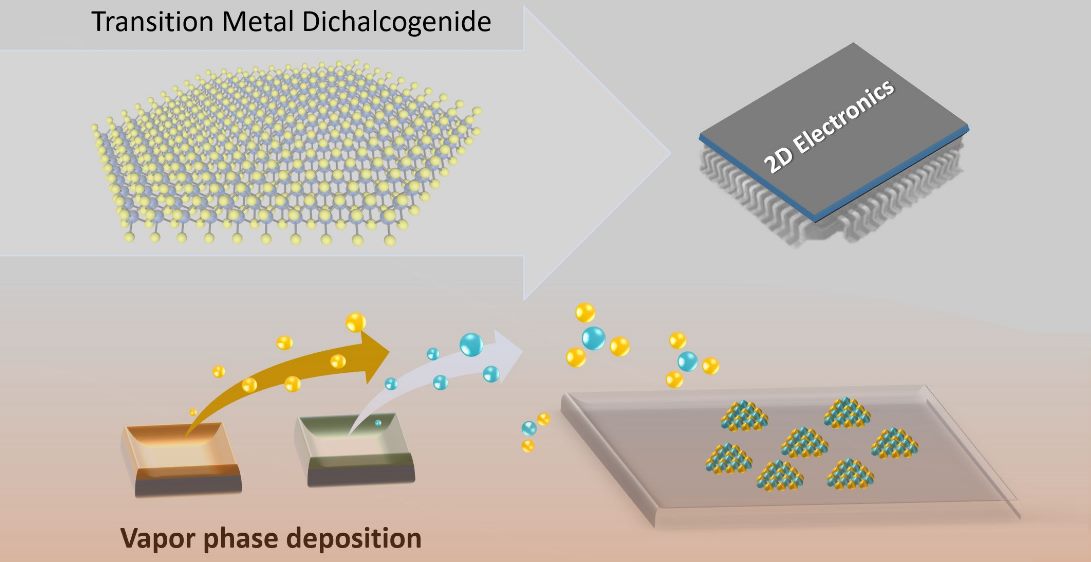
- Thermal-Assisted Vertical Electron Injections in Few-Layer Pyramidal-Structured MoS2 Crystals
作者: Pam Mei Er, Li Zibo, Ang Yee Sin, Shi Yumeng*, Geng Dechao, Huang Shaozhuan, Zhao Xiaoxu, Pennycook Stephen J, Yao Huizhen, Gong Xue, Ang Lay Kee, Yang HuiYing*
发表杂志: Jornal of Physical Chemistry Letters, 卷 10 期 6 页1292-1299
https://doi.org/10.1021/acs.jpclett.9b00274
摘要:
In this paper, we report a controllable CVD-grown monolayer MoS2 and layer-by-layer pyramidal-structured MoS2 crystals with an oxidized Mo foil precursor. The interlayer screening effects and charge conduction mechanisms in the pyramidal-structured MoS2 crystals are studied. Although the Fowler−Nordheim (FN) tunneling model is widely adopted to describe the vertical charge transport mechanism at the 2D semiconductor/bulk metal interface, we found that such a mechanism cannot satisfactorily explain the electrical measurement obtained from our CVD-grown MoS2 samples. Instead, our analysis reveals that Richardson−Schottky (RS) emission is the dominant transport mechanism when Vbias < 1 V. Our findings provide a fundamental understanding of the charge conduction mechanism in CVD-grown MoS2 crystals, which is crucial for development of MoS2 electronics and optoelectronics devices.


